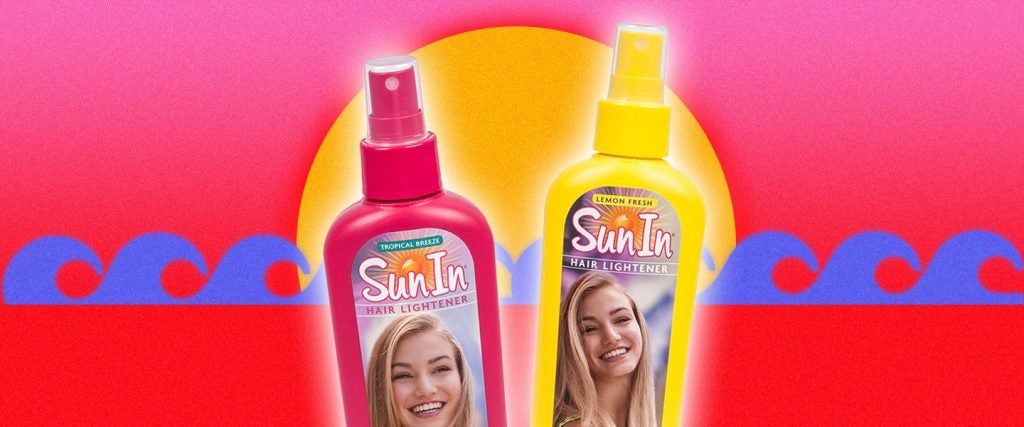For over 25 years, Hannah, a Virginia native and dirty blonde, has used the same product to lighten her hair — a $4.99 bottle of Sun-In. “It makes my hair look amazing, and gives it a natural lighter color,” she says.
From the late 1960s through the early aughts, as more and more people were looking to emulate the blonde, surfer-girl look, many turned to Sun-In, an elusive hair-lightening spray activated by the sun or the heat of a hair-dryer. By the time I was old enough to take notice in the late 1990s, all of my friends were drinking the peroxide and lemon juice Kool Aid, metaphorically speaking.
Personally, I was always jealous of girls like Hannah because my mom forbade me from using Sun-In out of fear that it would turn my hair orange. Yes, her concerns were valid, but part of the thrill of the spray was not knowing exactly what would happen after your hair was drenched in the drugstore spritz. But while many of us look back on this hair lightening heyday with nostalgia for a product firmly planted in another era, some Sun-In loyalists, like Hannah, stayed true to the brand.
Hannah, who started using Sun-In at 16, admits that friends and hairstylists have begged her to stop over the years, but she remains steadfast in her commitment. “My hairstylist tries to get me to dye it instead, but Sun-In still works wonders with me,” she says.
Other professionals in the industry are a little less gentle in their criticisms — like Cindy Marcus, who refers to Sun-In as “every hairstylist’s worst nightmare.” This is mostly because its main ingredient is hydrogen peroxide, which she warns can damage hair and strip its pigment. “More often than not, people will end up with an orange, brassy color,” she says.
And while some have memories of copper-colored hair from their Sun-In glory days, others mostly recall their peroxide-stained towels. Kevin, a 37-year-old who grew up in Redondo Beach in the 1990s, remembers when he attempted to give himself frosted tips, but only gave his mom yellow bath towels instead. “She still brings up the ruined towels to this day,” he says.
And yet, for every negative review on Amazon, or tale of an orange hair mishap on Reddit, there are just as many posts from people like Hannah who cast the spray in a positive light. In the past few years in particular, Sun-In has seen a bit of a resurgence brought on largely by Gen Z.
In 1974, Gillette sold Sun-In to the Tennessee-based manufacturing company Chattem, Inc., owned by the pharmaceutical giant Sanofi, but in July 2017, Focus Consumer Healthcare acquired the brand.
Since then, the comparatively smaller company of just nine full-time employees has revamped the Sun-In formula, per marketing director Brittany Dedman. Taking problems of the past into account, Dedman explains that the brand has lowered the level of peroxide and added chamomile, aloe and other botanical extracts to help condition the hair as it lightens. During the transition to a new formula, social platforms like Instagram and TikTok have given peroxide enthusiasts new avenues to flaunt their sunny tresses. The company also now employs 100 or so part-time “brand ambassadors” at college campuses across the country.
To Dedman, Sun-In isn’t meant to replace salon hair dye, but is more of an accessible “gateway drug into hair color,” especially since many young people can’t spend hundreds of dollars on salon highlights. “We’re not trying to put cosmetologists out of business; it’s a completely different consumer base,” Dedman says.
As such, at the age of 37, Dedman looks back at her Sun-In days of the 1990s, not with nostalgia, but with a sense of timelessness. “I remember grabbing a bottle of Sun-In and going and hanging out with my friends at the pool, and I don’t think any of that has changed,” she says. “There’s nothing like baking yourself on a chair with Sun-In in your hair.” At the same time, she acknowledges that the product isn’t for everyone: It should only be used on hair that’s never been dyed before, or “virgin hair,” and you should test it on a strip of hair first to make sure it doesn’t turn your head copper.
Dedman also acknowledges that plenty of people have less-than-pleasant memories associated with the spray. “Even the people who hate on the brand, that’s okay,” she says, adding that she likes to end those conversations by saying, “Stay sunny” — somewhat of a company line that doubles as a friendlier, more laid-back, “Screw you.”
After over two glorious, sun-drenched decades with Sun-In, Hannah takes a similar approach when her hairdresser gives her a hard time. “I always say I’ll dye it when I get older,” she jokes.

